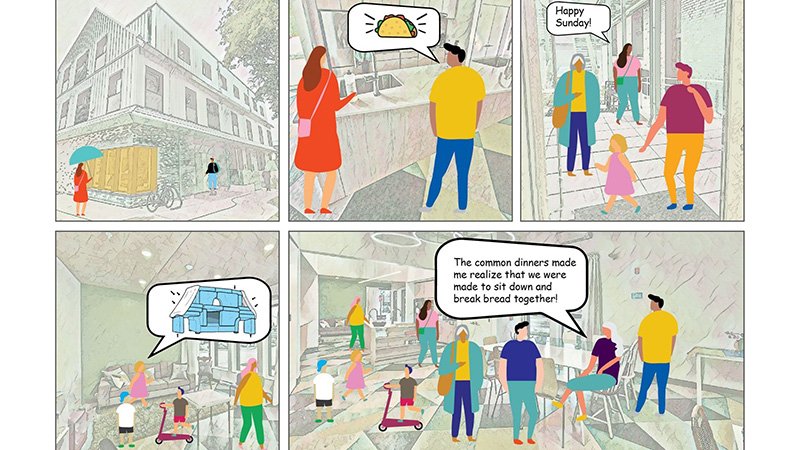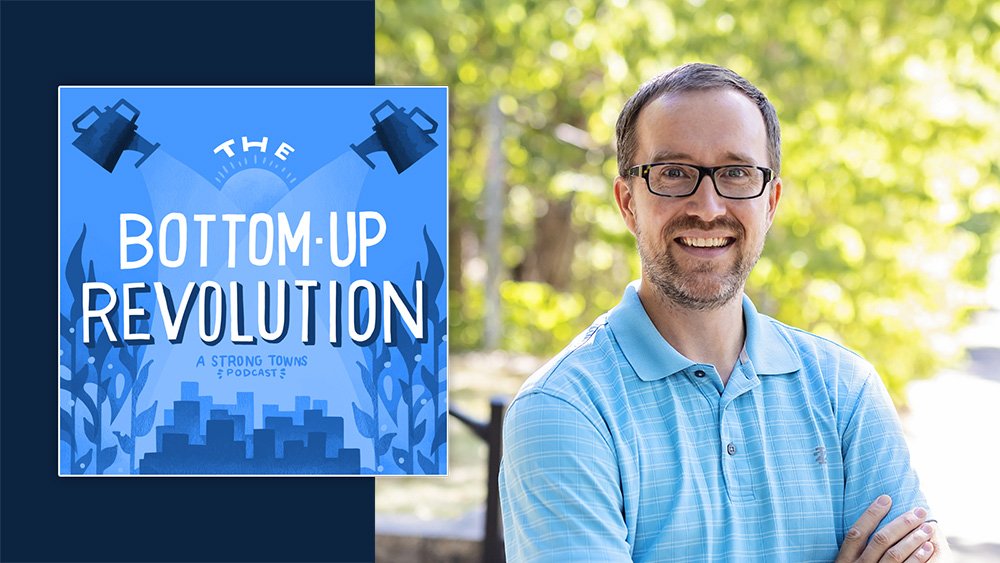Can Cohousing Solve the Housing Crisis and Loneliness Epidemic?
This article was originally published, in slightly different form, on the Happy Cities website. It is shared here with permission. All pictures were supplied by the writer.
A cozy Sunday evening at Our Urban Village. (Madeleine Hebert / Happy Cities)
It’s a rainy Sunday evening along south Main Street in Vancouver. The street outside is dark and lonely as trucks and buses rumble past. But at Our Urban Village Cohousing, there’s activity brewing in the common house — a shared kitchen and lounge area with large windows facing onto the street. This Sunday’s volunteer cook is preparing a shared meal (tacos!) for all the residents who want to join in.
Introducing: Our Urban Village
This group of people used to be strangers. But back in 2017, they found each other through a unique, shared project: They wanted to build a home together.
Like many people, they were tired of living in places where they rarely saw or talked to neighbors. They believed that by building a home with shared spaces and activities, they could nurture greater support and social connection.
“We’re a family of four, raising young kids in Vancouver, and we don't have a lot of family support locally,” said one resident. “So it was just kind of tough raising kids on our own. We've always been interested in living in community. We had looked into co-ops but [wanted] an option that was more like a strata model. And then, you know, lo and behold, such a thing does exist.”
This model is called cohousing: Residents own their private units, but share extensive common spaces. They commit to regular community activities, like meals, and manage the building together.
Our Urban Village adds gentle density to a largely residential neighborhood. (Madeleine Hebert / Happy Cities)
But developing a building for multiple households isn’t easy. The group was daunted by the idea of becoming developers in this expensive city, with complex regulations dictating what you are allowed to build and where. They wanted to find a way to fulfill their dream while reducing some of the demands on time, resources and expertise that developing cohousing typically requires.
That’s when they met Tomo Spaces, a local developer motivated to build better communities. Together, they decided to pilot a new model, partnering with Tomo to develop the building and then buying the units. They called this collaborative approach “cohousing lite.”
Over several years, Happy Cities worked with Our Urban Village (formerly called Tomo House) and the design team to help create a super social building — and then to measure whether residents really did feel more connected after moving into their new home. The cohousing lite project offers a promising new development model — for health, happiness and the planet. But to truly realize the potential for social good, we need to make this type of housing easier to build.
Designing a Happier Urban Village
Our Urban Village includes 12 private units, with residents ranging from 4 years old to over 70. The three-story building is designed around a shared courtyard, wide social walkways, and a common house where residents meet for meals and other gatherings. The community is built on the site of two former single-family lots, offering a gentle scale of “missing middle” housing in a largely residential neighborhood.
Our Urban Village on the corner of Main Street, Vancouver. (Matheson Photography)
Our Urban Village residents cooking together in the common house. (OUV Vancouver on Instagram)
Cohousing builds connections in part through regular communal meals, activities, meetings and shared management of the building. But design matters, too. Our research led us to believe that if the building was designed intentionally to foster social connections, residents would be more likely to feel happy, share a strong sense of belonging and trust one another.
We started by helping Tomo craft a vision and social well-being framework for the project. Then, we collaborated with Our Urban Village residents and MA+HG Architects throughout the design process to assess the social potential of all the spaces in the building and craft design strategies to nurture positive and trusting connections. Each design choice is intentional. For example, research suggests that regular, informal and unscheduled encounters nurture trust and belonging — often leading to deeper connections. So, the building includes wide outdoor walkways with social nooks for people to hang out in and is laid out so that most people pass by the courtyard and common house on their way from their unit to the parking area or street.
Social nook alongside an outdoor walkway with unit entrances. (Madeleine Hebert / Happy Cities)
Outdoor walkways at Our Urban Village connect directly to the courtyard. (Matheson Photography)
But the work didn’t stop there. We wanted to know whether people really did feel happier and healthier living in Our Urban Village compared to in their previous homes. So we conducted a study.
Measuring Changes in Wellbeing
Before and after residents moved in in 2023, we conducted surveys and interviews to ask people about things like their physical and mental health, their social connections, their engagement with their community and their trust in neighbors.
Residents feel more connected and less lonely six months after moving into Our Urban Village. (Happy Cities)
And, just six months after moving in, the results are impressive. Residents feel lonely less often and have more people to confide in than the average resident in their city. Remarkably, every single resident we surveyed reported that they never or rarely feel lonely, compared to just 40% before moving in, and 29% in Metro Vancouver.
We also saw an increase in the number of people who consider neighbors as friends or trust them enough to ask for favors. Just three months after moving in, everyone felt comfortable asking neighbors to borrow cooking ingredients, tools or appliances, and to water their plants or gardens. All but one reported feeling comfortable asking a neighbor to help if they were sick or injured, showing a strong sense of trust.
These well-being gains likely reflect both the commitment to building a community together and the increased number of opportunities for neighbors to bump into each other and say hello. Six months after moving in, every resident we surveyed said they now interact daily or weekly with their neighbors, compared to just 30% before.
These regular encounters help nurture stronger trust and relationships, and they're also good for our health: Studies show that people with strong social relationships live 15 years longer, on average, and that living in cohousing is linked with stronger social connections and support. All of this is accomplished by building space for 12 households on land that previously only housed one. Beyond the well-being benefits for the community of residents themselves, these forms of ‘infill’ housing help reduce carbon footprints by sharing walls and meeting passive design standards. But despite all the benefits, cohousing and other community housing forms remain rare in North America. If cohousing is good for us, why aren’t we building more of it?
Barriers to Creating an Urban Village
Cohousing is one promising solution to our loneliness crisis, but it is not yet easily accessible to everyone.
If you want to build a single home for just your family, for the most part, you’re allowed to do so anywhere in the city. But to construct a building for multiple households, developers have to navigate several additional policy processes, including rezoning, city council hearings, public engagement and more.
Expensive land, significant time commitments, high construction costs, complex policy requirements, limited areas to build multi-unit housing and long approval timelines prevent many projects from ever getting off the ground. By one estimate, a rezoning process alone can cost between $500,000 and $1 million. Big developers with deep pockets can absorb delays and added costs. But for nonprofits or smaller developers — including regular residents who want to build a home that better meets their needs — these barriers are often prohibitive.
All these challenges mean that it is hard for individuals and families to find housing options that aren't a single detached home or a high-rise condo. Typical multiunit buildings often consider social connection as an afterthought, if at all. Barriers to development and the high price of home ownership in this city restrict most housing choices to people who have the financial means.
Yet, the social support that cohousing brings has untapped potential to help nurture well-being among some of our most vulnerable residents. Low-income residents and other groups — such as seniors and newcomers — are more likely to experience social isolation than others. Community-oriented housing models can help. For example, sharing items and tasks among neighbors — like vehicles, household tools and appliances, communal meals, and even childcare — provides opportunities for neighbors to connect and also creates long-term cost savings.
“[We] generally have more people to ask questions of, and don’t need to ‘go it alone’,” wrote one resident after moving into Our Urban Village. “Some of this is borrowing a cup of sugar. Some of it is having other people to ask questions [to]. Also, the extraordinary relief of having other people cook meals for us twice a week, [which] takes the edge off having to do it ourselves always.”
Mixed-income communities that intentionally build connections among residents, such as Co:Here, also in Vancouver, offer another promising approach. But to make socially connected, multiunit housing options widely accessible, we need to make them easier to build. This means offering public land for affordable, socially connected housing; legalizing more density citywide; providing incentives to encourage social design features and offset the costs; and more. (We outline policy ideas in more detail in the research report.)
Hardwiring Social Connection Back Into Our Lives
As humans, we are hardwired for social connection. As one resident at Our Urban Village told us, since moving into the building, they have felt so convinced that “sitting down and breaking bread together is fundamental to being human.”
Cohousing brings a big change in daily routines, when most of us are used to living in homes with no expectation of being there for our neighbors. But nearly everyone we spoke with was surprised at how quickly they adapted to this new, joyful way of living.
“Unexpectedly, I found it quite difficult in the first month or so to transition to just having to be ‘available’ all the time,” wrote one resident. “[But] more than I expected, I’m finding it really pleasant to chat quickly with a neighbor in passing on my way in and out of the building.”
Back in the common house at Our Urban Village, the evening unfolds. Those who aren’t cooking do the dishes, set the table and catch up with the group. The kids build a couch fort in the lounge area and zoom around the big kitchen island — reveling in their incredible good fortune to have found a home full of friends.
Emma Avery is an urban geographer, storyteller and designer with a multidisciplinary background in anthropology, journalism and urban planning. She leads communications at Happy Cities and has completed urban planning, graphic design and communications work for municipalities across North America — all the way from St. Petersburg, Florida, to Vancouver, British Columbia. Emma completed her Master’s degree in Urban Geography at McGill University, where she conducted federally funded research on new, master-planned smart and green cities with the New Cities Lab.















